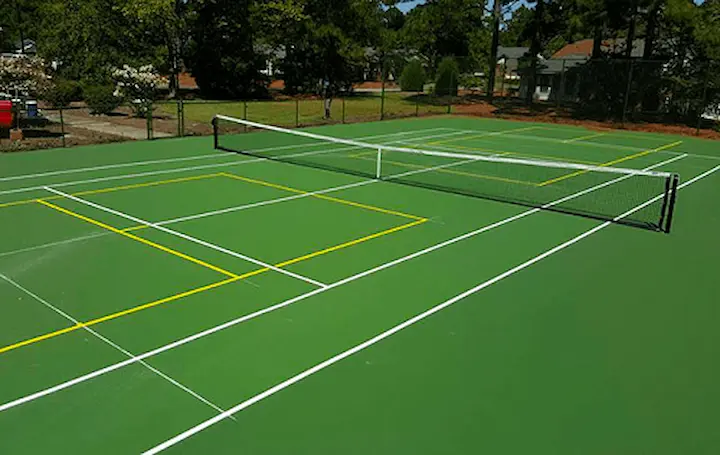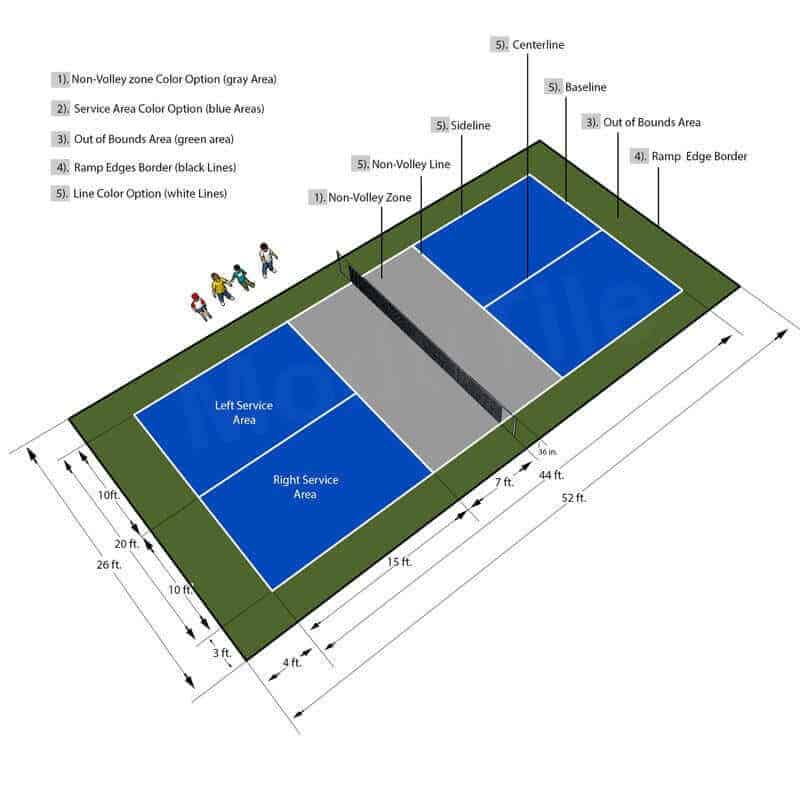Just how to Choose the very best Pickleball Judiciaries Layout & Construction in Illinois and Midwest
Secret Variables in the Construction of Pickleball Judiciaries: From Site Option to Final Finishes
The construction of pickleball courts incorporates a variety of crucial variables, beginning with the option of a proper website that balances accessibility with ecological considerations. Necessary elements such as court measurements, surface materials, and drainage systems dramatically affect not just the quality of play yet also the durability of the center. Attention to illumination and ending up touches can elevate the overall experience for gamers and spectators alike. Comprehending just how each of these components interrelates may disclose understandings that are frequently ignored, motivating a better assessment of ideal practices in court building.
Site Selection Criteria
When beginning on the building of pickleball courts, it is necessary to pin down the site choice requirements that will certainly make certain optimum playability and access. The area needs to be quickly reachable for players, ideally located near suburbs or recreation center, to encourage engagement.
In addition, the surface must be level and stable, as uneven ground can bring about safety and security dangers and impact gameplay. Sufficient drainage is additionally important; selecting a site with good water drainage will certainly help keep court problems during adverse climate.
One more important factor to consider is the schedule of utilities. Accessibility to power and water is required for lighting and upkeep purposes. In addition, distance to vehicle parking facilities is necessary, helping with easy gain access to for players and viewers alike.
Environmental aspects can not be forgotten; natural shade from trees can boost player convenience, while exposure to prevailing winds might interrupt play. Zoning policies and area support need to be thought about to make certain that the project lines up with neighborhood guidelines and gets the support it requires for successful application. By carefully assessing these standards, stakeholders can create an inviting and practical setting for pickleball fanatics.
Court Dimensions and Design
To make sure optimum gameplay and adherence to regulations, the dimensions and design of pickleball courts have to be carefully defined. A common pickleball court gauges 20 feet in width and 44 feet in length for both songs and doubles play. The recommended design includes a non-volley area, frequently described as the "cooking area," extending 7 feet from the net on either side. This area is critical, as it affects gamer positioning and shot selection - Illinois and midwest.
The net height is established at 36 inches at the sidelines and 34 inches at the facility, producing a minor dip that impacts sphere trajectory. Court markings are similarly essential; lines ought to be 2 inches wide and distinct in color to make certain presence.
In addition, a barrier zone surrounding the court is advisable, generally extending 5 to 10 feet past the sidelines and standards to suit gamers' movements and enhance safety and security. Correct design and dimensions not only make certain conformity with official regulations yet additionally improve the overall having fun experience, fitting both recreational and affordable play. Cautious planning in these locations is vital to the successful construction recommended you read of pickleball courts.
Surface Area Material Options
Picking the ideal surface material for pickleball courts is critical for ensuring ideal player performance and safety and security. The choice of surface area can considerably affect gameplay, including sphere bounce, grip, and player comfort.
There are a number of choices available, each with its distinct qualities. Asphalt is a prominent selection as a result of its resilience and reduced maintenance requirements. It offers a strong having fun surface that can endure numerous weather conditions but might require regular resurfacing.
Concrete is an additional extensively utilized material, supplying exceptional long life and a smooth coating. It enables for consistent ball bounce yet can be difficult on players' joints, making it much less preferable for lasting play without appropriate cushioning.
For those seeking boosted convenience and shock absorption, cushioned acrylic surfaces present a viable option. These surface areas combine a base layer with an acrylic topcoat, supplying improved grip and a softer feel, which is helpful for reducing the risk of injuries.
Finally, artificial lawn is gaining grip, specifically for multi-purpose facilities. Its flexibility and reduced upkeep requires make it an eye-catching option, though it may not provide the exact same round reaction as conventional difficult courts. Cautious factor to consider of these alternatives will certainly make certain an optimum having fun setting.
Drainage and Illumination Considerations
Correct drain and effective lights are crucial elements in the building of pickleball courts, significantly affecting both playability and security. Sufficient water drainage systems stop water build-up, which can lead to unsafe surface areas and damage to the court framework.
Lights is equally important, particularly for courts meant for night use. Appropriate lighting enhances exposure, ensuring that players can see the round plainly and decreasing the threat of accidents. The placement of illumination components should be tactically intended to eliminate shadows and supply even circulation of light across the court. LED lights are suggested for their power performance and longevity, providing brilliant lighting while reducing operational costs.

Final Finishes and Maintenance
After attending to drain and lights factors to consider, focus transforms to the last coatings and recurring upkeep of pickleball courts. Illinois and midwest. The selection of surface area product is critical, as it influences both playability and durability. Common options consist of acrylic coatings and specialized sporting activities surface areas that supply ideal traction and cushioning. These finishes should be used in numerous layers to make certain strength against weather components and put on.

Seasonal maintenance may consist of resurfacing every few years, depending upon usage and environmental elements. Properly maintaining internet, court lines, and bordering areas is similarly vital to provide a safe and pleasurable having fun experience. By investing in high quality coatings and adhering to an organized maintenance routine, center owners can guarantee their pickleball courts continue to be in superb condition for many years ahead.
Conclusion
Finally, the effective construction of pickleball courts depends upon careful focus to several essential aspects. Website selection ought to prioritize availability and surface security, while court measurements and layout must follow ideal requirements for gameplay. The selection of surface area product significantly influences player safety and performance. Additionally, efficient drain and appropriate illumination add to court durability and exposure. Quality finishes and a durable upkeep routine are vital for protecting the court's condition, enhancing the total experience for gamers and spectators alike.